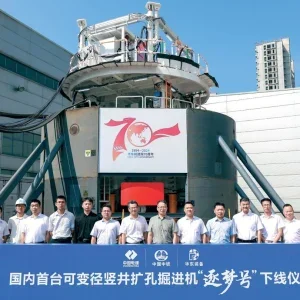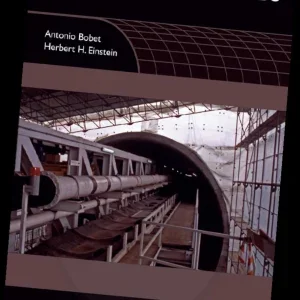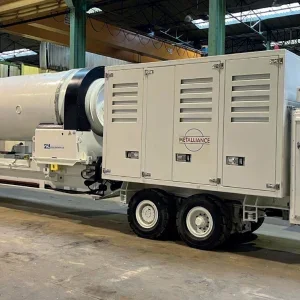The global tunnelling industry is worth USD 1.5tr, according to a new report released in August by Timetric. Leading the pack is Europe, with a project pipeline of almost USD 575bn. The report attributes the region’s economic success to high speed rail and metro expansion mega-projects. Seven projects in Europe with values over USD 20bn contribute 53 per cent of the total value in the region. These range from Crossrail and HS2 to the USD 38bn Lyon-Turin high speed rail project in France.
The Americas by contrast have tunnel projects valued at less than half of what Europe has in the pipeline—with, not coincidentally, fewer significant rail programs in North and South America compared to Europe. An outlier in the continent is California. A separate report released this summer by the University of California, Berkeley, summarises the economic impact of California’s rail system on the state.
“A broad investment in all types of transport has been critical to California’s economic success, and rail is a fundamental component of the transportation system. Rail has helped define California’s history, with westward expansion creating communities and allowing for growth in agriculture, and other early drivers of the state’s economy. With the coming high speed rail system and record traffic in containerised freight, it is also helping to define the state’s future.”
California has long been the economic powerhouse of the US. Its output is commonly compared not to its fellow states, but to countries, most recently ranking as the sixth largest economy in the world. It is also the first state building a high speed rail system, which will eventually total more than 800 miles (1,300km). Its mountainous terrain has planners looking at several significant lengths of tunnel drives, potentially up to 20 miles.
Major tunnelling works are expected in the northern parts of the alignment, across the Pacheco Pass, going toward San Francisco, and in the south through the Tehachapi Mountains, as the line travels to Los Angeles. Current estimates suggest a total of around 40-50 miles (64-80km) of tunnels could be required, with cover exceeding 2,000ft in some places.
Lengths aside, below ground is an array of challenges from seismic conditions to high groundwater pressures, methane gas and extremely variable geology. VALLEY TO VALLEY
The California High Speed Rail Authority (CHSRA) is the entity overseeing planning, design, construction and operation of the rail system—WSP is the program manager on behalf of CHSRA—and is delivering the project in two phases (Figure 1).
In the Central Valley construction has started on the first 119 miles of rail, divided into three contract packages and connecting Fresno to Bakersfield, budgeted at approximately USD 6bn. This stretch of the alignment is relatively flat and primarily at grade.
The program hopes to connect “Valley to Valley” – the Central Valley, north to Silicon Valley, as early as 2025. To do requires building the section of the line that will cross the Pacheco Pass, part of the Diablo mountain range, which could be among the next contracts to be released.
“We’re looking at 15 miles of tunnels in a non-dense area—a true mountain tunnelling project with multiple years of work,” says Randy Anderson, engineering manager, CHSRA.
The exact alignments have not yet been approved for the Pacheco Pass, but the horizontal alignment is fairly well established. “We’re looking at primarily one alignment right now,” he says.
The project started with two other alignments selected through a scoping process, which were among multiple variations analysed and refined with the Quantum computer program to identify viable routes. “It’s an iterative process that identifies the alignments that meet our defined area in engineering standards using actual digital geographic data.”
Both of these alignments were carried for a few years in preliminary alternative analysis, during which the engineering team met with stakeholders and did community outreach to get input.
Feedback in this period showed concern about the nearby San Luis Reservoir, prompting a third alignment to reduce environmental impacts. “There are really three alignments in play right now, but one alignment is narrowing in as more of a preferred alignment.”
This, the North Pacheco Alignment, has two tunnels of 1.5 miles and 13.5 miles. “We’re still evaluating our tunnel profile. We’re actually trying to raise up our tunnel profiles a little higher because of what we’re finding out with the geological conditions.
This third alignment is still in the preliminary alternative analysis, requiring completion of the environmental studies and more community outreach before staff will make a recommendation to the board. Once the board approves the PANOCHE
Coming out of San Felipe, to the west of the Pacheco Pass, the alignment enters an approximately 1.5-mile tunnel through the Panoche formation. “It’s of the Great Valley Sequence,” Anderson says. “It’s basically comprised of interbedded sandstone, shale and siltstone rocks. The sandstone is expected to be weak to medium strong, moderately bedded to massive. And the shale is expected to be extremely weak to weak strength, fine-grained, laminated to thinly bedded.
He anticipates weathering will be more pronounced in the portals, and the shallow ground cover sections of the tunnel where the rock is expected to be partially decomposed to highly weathered.
“The rocks have been affected structurally by regional scale tectonics associated with the Diablo Range,” he explains. “It’s undergone repeated folding and faulting resulting in several sections of significantly sheared and intensely fractured rock mass, ranging from 30-100ft (9-30m) along the route of the proposed tunnel.
Three active faults are located near the western boundary of the mountain range, responsible for these highly fractured, highly folded formations becoming massive, shear blocks. “We expect a majority of the tunnel to be wet with localised inflows of ground water up to 100 gallons per minute expected in our sheared and highly fractured sandstone and shale.” Near Tunnel 1 – about 3,000ft (1,000m) away – the federal government’s Bureau of Reclamation has the Santa Clara water tunnel, for which the engineering team has the construction records. The 10ft (3m) i.d. tunnel was built in the same Panoche formation but not as deep. It’s basically a pilot tunnel for the high speed rail project. “It gives us great information,” Anderson says. “We don’t expect the geological formation to change that much with depth. It’s fairly consistent.”
About 60 per cent of the ground for the water tunnel alignment comprised the interbedded shale and sandstone, about 15 per cent was shale, and about 20 per cent was sheared zones.
The previous project used a shielded TBM with temporary support of expanded steel sets with lagging at 4.5ft (1.4m) centers. “They reduced that steel lagging support to 1.5ft (0.45m) in shear zones,” he says. “That’s a clue right there that they were running into some problems with their loading. They significantly reduced their spacing of those steel sets in those sheared zones.”
Some of the construction problems on the water tunnel included overbreaks, over-excavation in the shale, highly fractured and sheared rock mass, and over-excavation in the shear zones with groundwater flow.
“We know exactly what they encountered. They had groundwater flow at their heading at about 100gal (450L) per minute and at the portal at about 3gal (14L) per minute. About half the tunnel was wet, and then about half of it was dry. It was a real mix for them.
“We have indication of squeezing ground but we don’t have any data per se. But we can tell by their reducing steel set spacing and the construction progress, Those are good indicators they ran into areas of squeezing ground.”
He shares more of the data: shear zones varied from 1/16th of an inch (1.6mm) to 70ft (21m) wide. “These were slight sheared zones between the rock, and then they had completely sheared zones up to 70ft.”
With the Panoche formation the engineering team can expect the same conditions and knows what the ground is made of. What is unknown are the lengths of the sheared zones. That can vary with depth, he explains, and is what the current investigations are seeking to clarify. “We’ll be able to characterise more of these sheared zones and the groundwater flows.”
As of now there is no excavation method specified, and the engineering team acknowledges contractors may prefer to use SEM with a tunnel of this length to eliminate the cross passages.
MELANGE
Following Tunnel 1, the alignment crosses a valley on a viaduct and travels along an embankment for a total of about 5 miles (8km) before the second underground portion of the alignment. Tunnel 2 is expected to be around 13.5 miles (22km) long with a maximum tunnel depth of about 1,100ft (335m).
“We have some deep cover and we have some shallow cover,” Anderson clarifies, “so only 3 per cent of Tunnel 2 do we expect to be in 1,000ft (305m) or greater tunnel depths. And then 70 per cent of the tunnel we expect to be less than 500ft, so you can see you’ve got a lot of peaks and valleys that we are diving under.”
Cover will be between 500-750ft (150-230m) for about 20 per cent of the tunnel. And the geology comprises mainly two formations, about two-thirds of which is the Franciscan complex and the other third the Panoche East of the Great Valley sequence.
The Franciscan complex has two distinct units, Anderson explains. One unit is the Franciscan mélange—a mixture of rocks of diverse origins and geologic ages enclosed in a fine matrix calledphyllonite.
“The phyllonite matrix has been pervasively disturbed by shearing or extensive submarine sliding and then indurated by metamorphism,” he says. “This formation came from the ocean bed and was thrust up, which makes up this Franciscan mélange.”
Strength of the rock varies from extremely weak to weak, and increases to medium strong when not sheared.
Sheared zones range up to 300ft (91m) in length. Also within the unit are metagraywacke and metashale rocks that are going to be strong to very strong, thickly to massively bedded. “That’s the Franciscan complex,” Anderson says, “you’ve got this mélange, this matrix, and then you have these large scale rock units, the metagraywacke and metashale, all mixed in with each other.”
The other part is similar to the Great Valley sequence of what Tunnel 1 is in, the Panoche East formation. “There we get back into the sandstones, conglomerates, shale and mudstone.”
The rocks are expected to be very weak to weak in strength, with some sections of medium strength rock. “Rock mass is overall structurally more confident, much less fractured and sheared when we compare it to the Panoche West.”
Anderson says of the Great Valley sequence the rock encountered at the end of Tunnel 2 will be better than the rock in which Tunnel 1 will be driven.
However, they are still formations that have undergone pervasive shearing and repeated folding and faulting, resulting in several sections of sheared and intensely fractured rocks.
“These sheared sections can be 50ft-300ft (15-91m) in length. We have massive sheared sections of these formations that we know are there. We have active faults on both sides of the Pacheco Pass, creating this constant tectonic movement of shearing and folding the formations.”
The majority of the tunnel is expected to be moist to wet. Due to the depth localised sections of high groundwater pressure inflows are expected in sheared shale around the graywacke and greenstone inclusions, and within the highly fractured greywacke rock masses. Some Piezometers and monitoring wells are already installed along the alignment. “We see water coming in, not real fast,” Anderson comments. “It fills up our monitoring wells, but at a very slow rate. I think it we were to put a hole in a sheared zone we would see water coming in much faster.”
In these formations expect squeezing ground, large deformations and face instability, he says, especially in the sheared mélange and under higher ground cover. “Because of the squeezing ground and the time dependent deformations we’re going to expect high loads on these tunnels. If we can try to raise our profile, reduce ground cover that will help us out. These are not formations like granite and hard rock that get an arching effect—this is just going to want to keep pushing the load down into the tunnel until you stabilise it.”
PREVIOUS PROJECT
Like Tunnel 1 there is an existing water tunnel near Tunnel 2, about 5.3 miles (8.5km) long and excavated with drill and blast. This tunnel is deeper by about 9.3m and offset from the high speed rail alignment. It’s a horse-shoe shaped, 9.5ft (2.9m) i.d. tunnel with maximum ground cover at about 1,300ft (400m), and 40 per cent of the alignment has cover greater than 800ft (240m). In addition to this project’s construction records and existing borings they’ve also provided CHSRA with the project’s mapping of the tunnel faces.
The engineering team knows the geology included the Franciscan complex, metagraywacke, metashale, mélange, as well as sheered zones for about 10 per cent of the alignment. The records also show the bedding was irregular and folded, and the mélange was foliated with discontinues parallel to the foliations.
“They used spiles in 40 per cent of tunnel to minimise their overbreak,” Anderson says. “They had overbreaks and over-excavations in the shale, highly fractured and sheered rock mass with groundwater flow, about 175gal (800L) per minute at the heading about 5gal (23L) per min at the portals.
“Thirty per cent of tunnel was wet or had inflow, and 70 per cent was dry,” he says, “Which is telling us as you hit these sheered areas you see more water flow. As mentioned previously the engineering team expects squeezing ground. Construction records from the water tunnel show progress slowing down as the contractor added steel sets, reducing steel spacing from 4ft to 2ft (1.2 to 0.6m). They did that in about 20 per cent of the tunnel alignment, Anderson says.
“They were getting this increased loading that their 4ft spacing couldn’t handle so they reduced their spacing to 2ft to deal with this initial loading during the initial excavation. Shearing was mainly in the mélange with sheared thicknesses of 0.5 inch to 100ft, and they had a 600ft length of a sheared section.” He says for the engineering team working on Tunnel 2 for the high speed rail project the big takeaway is to expect highly sheared zones, water flow in portions of the tunnel, and heavy loads with squeezing.
“We know what we’re getting into here,” he says, while mentioning, “we also expect to hit big graywacke rocks. So you’ll be going through this weak mélange and run into this interbedded rock formation of very high strength—a block that could be hundreds of feet in length. For tunnelling this is doable. You’ve just got be aware of it and you’ve got to select the right TBM.”
For now they are considering having some performance requirements written into the contract for the TBM to deal with the ground conditions, but for the most part leaving as much of the TBM selection to the contractor.
The project team is still evaluating how the two tunnels will be packaged, whether they are separate contracts, and if they are design-build. For Tunnel 2 if excavated as twin tunnels the design is looking at 28ft i.d. and potentially a contractor could have four TBMs on four headings. They’re also open to contractors doing a single bore of about 47 to 48ft (14.5m) diameter to eliminate the 89 cross passages that would be required of the twin tunnels at every 800ft. “That’s where it’s going to get interesting in the bidding,” Anderson says.
As of this autumn CHSRA is still working on the preliminary alterative analysis, engaging with the community and stakeholders, and moving toward getting board approval on a preferred alternative. Following that they can finish the draft EIR/EIS in preparation for public comment. After finishing the final EIR/EIS, and with board notice of decision certification CHSRA will secure a Federal Railroad Administration decision. To build the entire system estimates have ranged from USD 30bn to USD 100bn, and currently hover around USD 64bn. CHSRA points out high-speed rail will alleviate the need for California to build—at a cost of nearly USD 100bn—about 3,000 miles of new freeway plus five airport runways and 90 departure gates over the next two decades.
Capital funding to develop the system is coming from federal, state, local and private sources. Voters in California passed a ballot measure in 2008 to allocate funds for high speed rail, an initial USD 9.95bn. While critics bemoan the decision to start the line at smaller cities (Fresno and Bakersfield) as opposed to San Francisco or Los Angeles, there is still popular support for the project. According to a survey published last year by the Public Policy Institute of California 34 per cent of residents view the program as “very important for the future of California,” and 52 per cent of Californians favor building the system.






